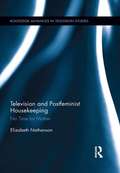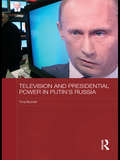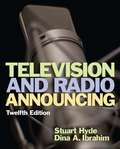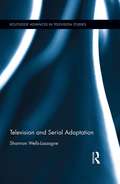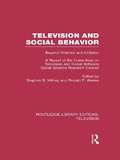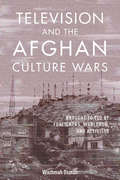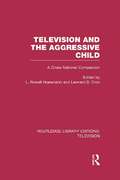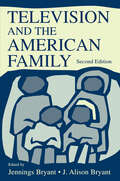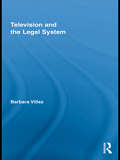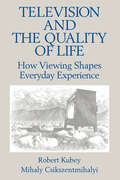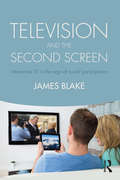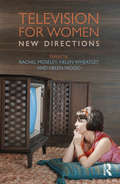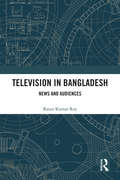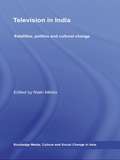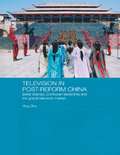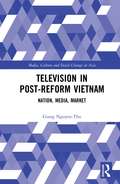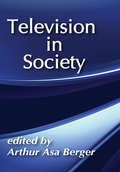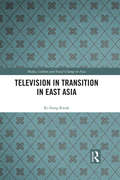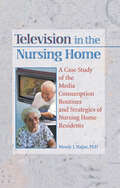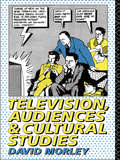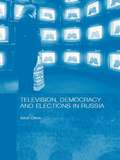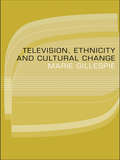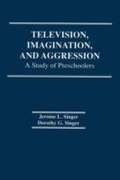- Table View
- List View
Television and Postfeminist Housekeeping: No Time for Mother (Routledge Advances in Television Studies #3)
by Elizabeth NathansonIn this book, Nathanson examines how contemporary American television and associated digital media depict women’s everyday lives as homemakers, career women, and mothers. Her focus on American popular culture from the 1990s through the present reveals two extremes: narratives about women who cannot keep house and narratives about women who only keep house. Nathanson looks specifically at the issue of time in this context and argues that the media constructs panics about domestic time scarcity while at the same time offering solutions for those very panics. Analyzing TV programs such as How Clean is Your House, Up All Night, and Supernanny, she finds that media’s portrayals of women’s time is crucial to understanding definitions of femininity, women’s labor, and leisure in the postfeminist context.
Television and Presidential Power in Putin's Russia (BASEES/Routledge Series on Russian and East European Studies)
by Tina BurrettAs a new president takes power in Russia, this book provides an analysis of the changing relationship between control of Russian television media and presidential power during the tenure of President Vladimir Putin. It argues that the conflicts within Russia’s political and economic elites, and President Putin’s attempts to rebuild the Russian state after its fragmentation during the Yeltsin administration, are the most significant causes of changes in Russian media. Tina Burrett demonstrates that President Putin sought to increase state control over television as part of a larger programme aimed at strengthening the power of the state and the position of the presidency at its apex, and that such control over the media was instrumental to the success of the president’s wider systemic changes that have redefined the Russian polity. The book also highlights the ways in which oligarchic media owners in Russia used television for their own political purposes, and that media manipulation was not the exclusive preserve of the Kremlin, but a common pattern of behaviour in elite struggles in the post-Soviet era. Basing its analysis predominately on interviews with key players in the Moscow media and political elites, and on secondary sources drawn from the Russian and Western media, the book examines broad themes that have been the subject of constant media interest, and have relevance beyond the confines of Russian politics.
Television and Public Policy: Change and Continuity in an Era of Global Liberalization
by David WardThe significant changes that have swept the television industry over the last two decades, most notably a shift to deregulation in broadcast media, prompt a discussion on how to ensure that meaningful content is available to the viewer. Television and Public Policy analyzes the current state of television systems in a selected group of countries by exploring the political, economic, and technological factors that have shaped the sector in such a short span of time. Consequently, by positioning the television sector within issues of media policy and the regulatory framework, the book questions what these trends mean for television, and the historical, political, and cultural role in our societies. Television and Public Policy distinguishes itself in several ways:*It is a global project in its comparative scope and subject area. Contributors represent countries including Australia, Brazil, Canada, China, Egypt, India, Iran, Ireland, Israel, Italy, Japan, the Netherlands, New Zealand, Poland, the United Kingdom, and the United States.*It is contemporary and filled with information largely absent in current literature.*It offers original analysis of the contemporary television sector. This book speaks to a broad range of academics, postgraduate, and undergraduate students, and can serve as a key resource for courses ranging from media studies, to development studies, international relations, and law.
Television and Radio Announcing, Twelfth Edition
by Stuart Hyde Dina A. IbrahimThe digital revolution has significantly changed broadcast technology. The 12th edition of Television and Radio Announcing reflects new trends in the field, such as the reconfiguration of electronic media production practices and distribution models. The internet and social media have opened up new access to production and new methods of distribution, such as YouTube, Facebook, Twitter, and podcasts. The 12th edition addresses the realities of students who live in this new era.
Television and Serial Adaptation (Routledge Advances in Television Studies)
by Shannon Wells-LassagneAs American television continues to garner considerable esteem, rivalling the seventh art in its "cinematic" aesthetics and the complexity of its narratives, one aspect of its development has been relatively unexamined. While film has long acknowledged its tendency to adapt, an ability that contributed to its status as narrative art (capable of translating canonical texts onto the screen), television adaptations have seemingly been relegated to the miniseries or classic serial. From remakes and reboots to transmedia storytelling, loose adaptations or adaptations which last but a single episode, the recycling of pre-existing narrative is a practice that is just as common in television as in film, and this text seeks to rectify that oversight, examining series from M*A*S*H to Game of Thrones, Pride and Prejudice to Castle.
Television and Social Behavior: Beyond Violence and Children / A Report of the Committee on Television and Social Behavior, Social Science Research Council (Routledge Library Editions: Television)
by Stephen B. Withey and Ronald P. AbelesThis book, published originally in 1980, addressed the needs for a profile of televised violence which considered the advantages and disadvantages of various measures and for a furthering of research directions beyond the then-popular emphasis on children. The Committee on Television and Social Behavior was formed in1972 and stimulated new research in order to provide a multidimensional profile of the social effects of television programming. Chapters here look at the effect of television on adults as well as children, particularly special audiences such as the elderly and minority groups. An excellent summary of the various conceptual, substantive and methodological issues around television’s influence.
Television and the Afghan Culture Wars: Brought to You by Foreigners, Warlords, and Activists (The Geopolitics of Information #12)
by Wazhmah OsmanPortrayed in Western discourse as tribal and traditional, Afghans have in fact intensely debated women's rights, democracy, modernity, and Islam as part of their nation building in the post-9/11 era. Wazhmah Osman places television at the heart of these public and politically charged clashes while revealing how the medium also provides war-weary Afghans with a semblance of open discussion and healing. After four decades of gender and sectarian violence, she argues, the internationally funded media sector has the potential to bring about justice, national integration, and peace. Fieldwork from across Afghanistan allowed Osman to record the voices of many Afghan media producers and people. Afghans offer their own seldom-heard views on the country's cultural progress and belief systems, their understandings of themselves, and the role of international interventions. Osman analyzes the impact of transnational media and foreign funding while keeping the focus on local cultural contestations, productions, and social movements. As a result, she redirects the global dialogue about Afghanistan to Afghans and challenges top-down narratives of humanitarian development.
Television and the Aggressive Child: A Cross-national Comparison (Routledge Library Editions: Television)
by L. Rowell Huesmann and Leonard D. EronThe research presented in this book, originally published in 1986, looks to pinpoint the psychological processes involved in the media violence-aggression relation. Expanding on earlier studies, the compilation of essays here delves deeply into aggression study and compares results about media influence across 5 countries. Cultural norms and programming differences are investigated as well as age and gender and other factors. What is offered overall is a psychological model in which TV violence is both a precursor and a consequence of aggression.
Television and the American Family
by J. Alison BryantThis second edition of a trend-setting volume provides an updated examination of the interaction between families and the most pervasive mass medium: television. Charting the dynamic developments of the American family and television over the past decade, this volume provides a comprehensive representation of programmatic research into family and television and examines extensively the uses families make of television, how extensions of television affect usage, families' evolving attitudes toward television, the ways families have been and are portrayed on television, the effects television has on families, and the ways in which families can mediate its impact on their lives. The volume is an invaluable resource for scholars and students in the areas of media and society, children and media, and family studies.
Television and the Legal System (Routledge Studies in Law, Society and Popular Culture)
by Barbara VillezThis book examines the American television legal series from its development as a genre in the 1940s to the present day. Villez demonstrates how the genre has been a rich source of legal information and understanding for Americans. These series have both informed and put myths in place about the legal system in the US. Villez also contrasts the US to France, which has seen a similar interest in legal series during this period. However, French television representations of justice are strikingly different, as is the role of fiction in offering viewers the possibility of acquiring significant understandings of their legal system. The book will be an important addition to the study of popular culture and law and will interest legal scholars, sociologists, and media scholars.
Television and the Quality of Life: How Viewing Shapes Everyday Experience (Routledge Communication Series)
by Robert Kubey Mihalyi CsikszentmihalyiEmploying a unique research methodology that enables people to report on their normal activities as they occur, the authors examine how people actually use and experience television -- and how television viewing both contributes to and detracts from the quality of everyday life. Studied within the natural context of everyday living, and drawing comparisons between television viewing and a variety of other daily activities and leisure pursuits, this unusual book explores whether television is a boon or a detriment to family life; how people feel and think before, during, and after television viewing; what causes television habits to develop; and what causes heavy viewing -- and what heavy viewing causes -- in the short and long term. Television and the Quality of Life also compares the viewing experience cross-nationally using samples from the United States, Italy, Canada, and Germany -- and then interprets the findings within a broad theoretical and historical framework that considers how information use and daily activity contribute to individual, familial, societal, and cultural development.
Television and the Second Screen: Interactive TV in the age of social participation
by James BlakeTelevision is changing almost beyond recognition. In the battle for consumers, social media sites, smart phones and tablets have become rivals to traditional linear TV. However, audiences and producers are also embracing mobile platforms to enhance TV viewing itself. This book examines the emerging phenomenon of the second screen: where users are increasingly engaging with content on two screens concurrently. The practice is transforming television into an interactive, participatory and social experience. James Blake examines interactive television from three crucial angles: audience motivation and agency, advances in TV production and the monetisation of second screen content. He also tracks its evolution by bringing together interviews with more than 25 television industry professionals - across the major UK channels - including commissioning editors, digital directors, producers and advertising executives. These reveal the successes and failures of recent experiments and the innovations in second screen projects. As the second screen becomes second nature for viewers and producers, the risks and opportunities for the future of television are slowly beginning to emerge. Television and the Second Screen will offer students and scholars of television theory, industry professionals and anyone with an abiding interest in television and technology, an accessible and illuminating guide to this important cultural shift.
Television for Women: New Directions
by Helen Wheatley Rachel Moseley Helen WoodTelevision for Women brings together emerging and established scholars to reconsider the question of ‘television for women’. In the context of the 2000s, when the potential meanings of both terms have expanded and changed so significantly, in what ways might the concept of programming, addressed explicitly to a group identified by gender still matter? The essays in this collection take the existing scholarship in this field in significant new directions. They expand its reach in terms of territory (looking beyond, for example, the paradigmatic Anglo-American axis) and also historical span. Additionally, whilst the influential methodological formation of production, text and audience is still visible here, the new research in Television for Women frequently reconfigures that relationship. The topics included here are far-reaching; from television as material culture at the British exhibition in the first half of the twentieth century, women’s roles in television production past and present, to popular 1960s television such as The Liver Birds and, in the twenty-first century, highly successful programmes including Orange is the New Black, Call the Midwife, One Born Every Minute and Wanted Down Under. This book presents ground-breaking research on historical and contemporary relationships between women and television around the world and is an ideal resource for students of television, media and gender studies.
Television in Bangladesh: News and Audiences
by Ratan Kumar RoyThis book examines the role of 24/7 television news channels in Bangladesh. By using a multi-sited ethnography of television news media, it showcases the socio-political undercurrents of media practices and the everydayness of TV news in Bangladesh. It discusses a wide gamut of issues such as news making; localised public sphere; audience reaction and viewing culture; impact of rumours and fake news; socio-political conditions; protest mobilization; newsroom politics and perspectives from the ground. An important intervention in the subject, this book will be useful to scholars and researchers of media studies, journalism and mass communication, anthropology, cultural studies, political sociology, political science, sociology, South Asian studies, as well as television professionals, journalists, civil society activists, and those interested in the study of Bangladesh.
Television in India: Satellites, Politics and Cultural Change (Media, Culture and Social Change in Asia)
by Nalin MehtaThis book examines the development of television in India since the early 1990s, and its implications for Indian society more widely. Until 1991, India possessed only a single state-owned television channel, but since then there has been a rapid expansion in independent satellite channels which came as a complete break from the statist control of the past. This book explores this transformation, explaining how television, a medium that developed in the industrial West, was adapted to suit Indian conditions, and in turn has altered Indian social practices, making possible new ways of imagining identities, conducting politics and engaging with the state. In particular, satellite television initially came to India as the representative of global capitalism but it was appropriated by Indian entrepreneurs and producers who Indianized it. Considering the full gamut of Indian television - from "national" networks in English and Hindi to the state of regional language networks – this book elucidates the transformative impact of television on a range of important social practices, including politics and democracy, sport and identity formation, cinema and popular culture. Overall, it shows how the story of television in India is also the story of India's encounter with the forces of globalisation.
Television in Post-Reform China: Serial Dramas, Confucian Leadership and the Global Television Market (Media, Culture and Social Change in Asia #9)
by Ying ZhuThis book explores the political, economic, and cultural forces, locally and globally that have shaped the evolution of Chinese primetime television dramas, and the way that these dramas in turn have actively engaged in the major intellectual and policy debates concerning the path, steps, and speed of China’s economic and political modernization during the post-Deng Xiaoping era. It intertwines the evolution of Chinese television drama particularly with the ascendance of the Chinese New Left that favors a recentralization of state authority and an alternative path towards China’s modernization and China’s current administration’s call for building a "harmonious society." Two types of serial drama are highlighted in this regard, the politically provocative dynasty drama and the culturally ambiguous domestic drama. The book also provides cross-cultural comparisons that parallel the textual and institutional strategies of transnational Chinese language TV dramas with dramas from the three leading centers of transnational television production, the US, Brazil and Mexico in Latin America, and the Korean-led East Asia region. The comparison reveals creative connections while it also explores how the emergence of a Chinese cultural-linguistic market, together with other cultural-linguistic markets, complicates the power dynamics of global cultural flows.
Television in Post-Reform Vietnam: Nation, Media, Market (Media, Culture and Social Change in Asia)
by Giang Nguyen-ThuThis book explores Vietnamese popular television in the post-Reform era, that is, from 1986, focussing on the relationship between television and national imagination. It locates Vietnamese television in the experiences of everyday life and the prevailing network of power relations resulting from marketization and globalization, and, as such, moves beyond the clichéd assumption of Vietnamese media as a mere propagandist instrument of the party state. With examples from a wide range of television genres, the book demonstrates how Vietnamese television enables novel conditions of cultural oppression as well as political engagement in the name of the nation. In sharp contrast to the previous image of Vietnam as a war-torn land, post-Reform television conjures into being a new sense of national belonging based on an implicit rejection of the socialist past, hopes for peace and prosperity, and anxieties about a globalized future. This book highlights the richness of Vietnam’s current culture and identity, characterized, the book argues, by ‘fraternity without uniformity’.
Television in Society
by Arthur Asa BergerIs television a cultural wasteland, or a medium that has brought people more great art, music, dance, and drama than any previous media? How do we study and interpret television? What are the effects of television on individuals and society, and how do we measure them? What is the role of television in our political and economic life? Television in Society explores these issues in considering how television both reflects and affects society.The book is divided into two sections. The first focuses on programming and deals with commercials, ceremonial events, important series (such as ""MASH"" and ""Lou Grant""), significant programs (a production of Brave New World on television), and the images of police on the medium. The second part of the book deals with important issues and topics related to the medium: the impact of television violence, values found on television, the impact of television on education, the significance of new technological developments, and the always thorny issue of freedom of the press. The articles are drawn together by a brilliant introductory essay by Arthur Asa Berger, who examines television as culture.
Television in Transition in East Asia (Media, Culture and Social Change in Asia)
by Ki-Sung KwakThis book examines the development of television broadcasting in Japan, Hong Kong and South Korea. It explores the policy regimes guiding the development of television broadcasting as a powerful institution and the extent to which new forms of television have become part of each country’s contemporary media mix. It analyses the interests involved in key policy decisions, the institutional dynamics promoting or inhibiting new media markets, and the relative importance in the different countries of cable, satellite, digital broadcasting, and the use of the Internet for purposes associated with television broadcasting. The nature of television regimes in each of the three countries is very different, and the contrasting situations provide great insights into how television is developing, and how it could develop further, both in East Asia and worldwide.
Television in Turkey: Local Production, Transnational Expansion and Political Aspirations
by Yeşim Kaptan Ece AlganThis edited collection takes a timely and comprehensive approach to understanding Turkey’s television, which has become a global growth industry in the last decade, by reconsidering its geopolitics within both national and transnational contexts. The Turkish television industry along with audiences and content are contextualised within the socio-cultural and historical developments of global neoliberalism, transnational flows, the rise of authoritarianism, nationalism, and Islamism. Moving away from Anglo-American perspectives, the book analyzes both local and global processes of television production and consumption while taking into consideration the dynamics distinctive to Turkey, such as ethnic and gender identity politics, media policies and regulations, and rising nationalistic sentiments.
Television in the Nursing Home: A Case Study of the Media Consumption Routines and Strategies of Nursing Home Residents
by Wendy J HajjarTelevision in the Nursing Home: A Case Study of the Media Consumption Routines and Strategies of Nursing Home Residents is a three-stage ethnographic study of media use by the elderly in long-term care facilities. This research concludes that watching television is the most prevalent and pervasive activity for patients. Activity directors can now learn how television and media can offer diversion, enhancement of personality, awareness, and sociability to their patients and offers suggestions on roommate coordination, selection of appropriate media, and communication resources. Containing the latest knowledge involving communication and gerontology, Television in the Nursing Home will help you offer programs that will meet the demands of an expanding elderly population.Developed as a perspective for examining patterns of social interaction, Television in the Nursing Home gives suggestions on how you can use the media to create new activities for patients, maximizing the television as a resource for the elderly. You will gain valuable insight on: proof to dispel the myth that television in long-term patient care causes withdrawal and depression a breakthrough in the treatment of media and aging, enhancing media-based activities and the use and purchase of electronic equipment for care facilities studies on how and why television is the most accessible medium of communication information for the development of new media designed specifically for use by the elderly creation of media-centered activities that recognize the potential for therapeutic use of communication technologies in the nursing homeThe research presented in Television in the Nursing Home establishes the fact that television consumption, once thought to be problematic, should be seen as desirable and necessary. This important book also proves how television is a resource that provides comfort, self-expression, and sociality. This first-ever study will convince you that television and media use in long-term care is beneficial and essential to the wellness of your patients.
Television, Audiences and Cultural Studies
by David MorleyTelevision, Audiences and Cultural Studies presents a multi-faceted exploration of audience research, in which David Morley draws on a rich body of empirical work to examine the emergence, development and future of television audience research. In addition to providing an introductory overview from a cultural studies perspective, David Morley questions how class and cultural differences can affect how we interpret television, the significance of gender in the dynamics of domestic media consumption, how the media construct the `national family', and how small-scale ethnographic studies can help us to understand the global-local dynamics of postmodern media systems.Morley's work reconceptualises the study of `ideology' within the broader context of domestic communications, illuminating the role of the media in articulating public and private spheres of experience and in the social organisation of space, time and community.
Television, Democracy and Elections in Russia (BASEES/Routledge Series on Russian and East European Studies)
by Sarah OatesSarah Oates gives a detailed examination on a central theme in political science: the relationship between democracy and the mass media. This significant book contains a wealth of information and data, including: public opinion surveys, content analysis of television news, focus groups and in-depth interviews to examine why political parties and the mass media failed so spectacularly to aid in the construction of a democratic system in Russia. The analysis presents compelling evidence that television helped to tune out democracy as it served as a tool for leaders rather than a conduit of information in the service of the electorate or parties. In addition, focus groups and surveys show that the Russian audience are often more comfortable with authority rather than truth in television coverage. Within this framework, this fascinating work presents the colourful history of parties, elections and television during one of the most critical eras in Russian history and captures a particularly significant epoch in contemporary Russian politics.
Television, Ethnicity and Cultural Change (Comedia)
by Marie GillespieFor 'ethnic minorities' in Britain, broadcast TV provides powerful representations of national and 'western' culture. In Southall - which has the largest population of 'South Asians' outside the Indian sub-continent - the VCR furnishes Hindi films, 'sacred soaps' such as the Mahabharata, and family videos of rites of passage, as well as mainstream American films. Television, Ethnicity and Cultural Change examines how TV and video are being used to recreate cultural traditions within the 'South Asian' diaspora, and how they are also catalysing cultural change in this local community.Marie Gillespie explores how young people negotiate between the parental and peer, local and global, national and international contexts and culturess which traverse their lives. Articulating their own preoccupations with television narratives, they both reaffirm and challenge parental traditions, formulating their own aspirations towards cultural change.Marie Gillespie's in-depth study offers an invaluable survey of how cultures are shaped and changed through people's recreative reception of the media.
Television, Imagination and Aggression: A Study of Preschoolers
by Dorothy G. Singer Jerome L. SingerPreschoolers Study
